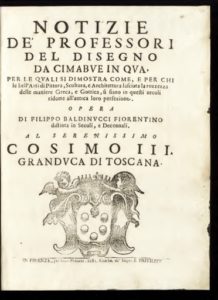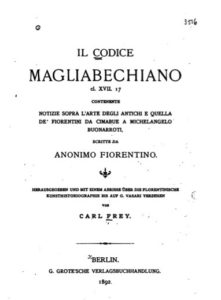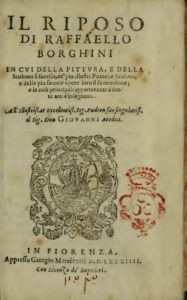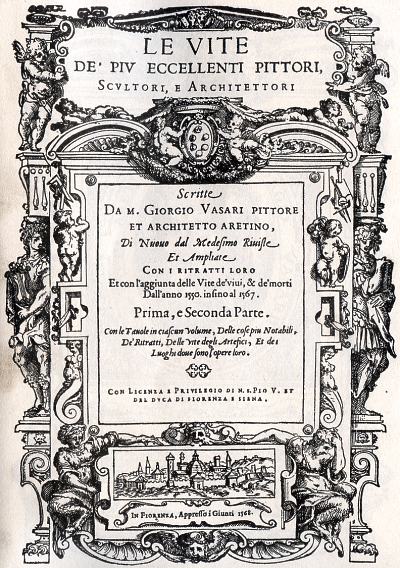
In his discussion of the Camposanto in Pisa illustrata nelle arti del disegno of 1787, Alessandro da Morrona refers explicitly to other authors such as Roncioni and Tronci. He begins by describing how the Pisans fought in the Holy Land, and how Ubaldo Lanfranchi brought the holy earth back to Italy and bought a piece of land next to the Cathedral. Giovanni Pisano is described as the architect that built the Camposanto in 1278 under Federico Visconti following the ideas of Ubaldo. Morrona also refers to Vasari and writes about the power of the holy earth, that it once had the ability to decompose bodies in twenty-four hours but that it had now lost this power. /SB
Pisa_illustrata_nelle_arti_del_disegno (excerpt)
Source: Alessandro da Morrona, Pisa Illustrata Nelle Arti Del Disegno, 3 vols. (Pisa: Francesco Pieraccini, 1787-1793), 2:171-173, 179-180, 238-239.
Transcription
“L’ordine cronologico ad illustrar m’invita il celebre Campo Santo, grandioso monumento dell’opulenza della Pisana Repubblica, e dell’Architettura del sec. XIII, a cui niuno altro d’Italia s’agguaglia relativamente al fine onde i Pisani lo destinarono. L’origine del nascimento suo chiara risulta dalla istoria del Can. Roncioni, da Paolo Tronci, dall Ughelli, da altre autorevoli carte ancora. Narrano essi, che l’Arcivescovo Ubaldo de Lanfranchi, quando ad instanza di Clemente III. Nell’anno 1188 andò contro i Turchi, come capo dell’esercito pisano, unitamente alle altre due marittime Potenze, Veneziana e Genovese, fin presso Gerusalemme si condusse; e poiché tenendo stretto dentro le mura quel presidio ebbe comodo di visitare il monte calvario pietoso desìo lo mosse a far levare molta terra ed a mandarla all’armata composta o più navi. Trasferitosi poscia dove le altre Potenze erano intente all’assedio di Tolemaide, che fu circa all’anno 1191 narrasi, che dalla sorte il total comando ci ricevesse dalle medesime. Ma nel terzo giorno del suo decoroso governo (onde Pisa per tre giorni ebbe voce della Signorìa del Mondo,) nato scompiglio nel campo per la trista nuova della morte dell’Imperator Federigo, colse il tempo Saladino capo dei Saraceni, ed attaccò una fiera mischia con grave danno, e strage degli intimoriti Cristiani. Per lo che Ubaldo radunate le genti, che campate avea si ritirò all’armata, e date le vele al vento fece ritorno alla Patria con poco onore ed utile, scrisse l’Anonimo nella sua istoria pisana. Allora fu, ch’ei comprò presso al Duomo porzione di terreno; e fatta quivi collocare la trasportata terra, adattò quel sito per uso di Cimitero. Sub eodem Presule (scrisse il Volterrano) Campum Sanctum dicavere ex terra, quam Hyerosolimis adducerunt, injecta nuncupatum.
Senza errore adunque gli Autori scrissero, e direm’ noi con essi che l’idea primiera di questo Campo Santo concepita fu da Ubaldo Arcivescovo nell’anno 1200: e che posteriormente nell’anno 1278 come la seguente iscrizione insegna, fu innalzata la gran Fabbrica sì fastosamente come al presente si vede col disegno, e colla direzione di Giovanni da Pisa, essendo Arcivescovo Federigo della splendida famiglia de’ Viceconti.
L’iscrizione è in marmo incisa nello spazio dell’arcata laterale a quella ov’è il principale ingresso. Tralasciando alcune stravaganti ma chiare abbreviature, ella è così concepita,
A.D. MCCLXXVIII / TEMPORE DNI. FEDERIGI ARCHIEPI. PIS. / ET DNI. TERLATI POTESTATIS / OPERAIO ORLANDO SARDELLA: / JOHANNE MAGISTRO EDIFICANTE. […]
L’interna architettonica parte della region funebre con tali oggetti di magnificenza e di grandezza, e sì copiosamente decorata d’opere di Scultura e di Pittura si presenta, che l’animo ne concepisce dilettazione e meraviglia. […] Quattro ampie logge in forma di parallelogrammo racchiudono il gran claustro scoperto, ove in tre campi divisa fu posta la mentovata terra santa, la quale al dir del Vasecio riduceva i cadaveri in polvere nel solo spazio di 24 ore, attività già da gran tempo perduta. […]
Fu osservato dal Vasari un romito che munge una capra pel pregio della naturalezza. Altro ne additò, denominandolo S. Macario, che fattosi incontro a certi Cavalieri mostra ad essi l’umana miseria ne i tre Rè, che morti giacciano ne’sepolcri, e che distingueno i tre diversi stati del corpo di spirto privo fino alla sua total corruzione giusta i pretesi effetti della terra santa in altro luogo nominati. In essi uso l’Orcagna attitudini dicevoli, e proprie alla trista considerazione; e per far cosa analoga al primo disegno, vi effigiò varj Signori contemporanei.”
Translation
The chronological order leads me to present the famous Camposanto, the grandiose monument originating from the opulence of the Pisan Republic and the architecture of the thirteenth century, with which no other [monument] in Italy can be compared and from where the Pisans derive their destiny. The origin of its birth comes from the story of Can. Roncioni, by Paolo Tronci, by Ughelli, and also from the texts of other authors. These tell that the Archbishop Ubaldo Lanfranchi, by order of Clement III in 1188, under the leadership of the Pisans and united with the other naval powers of Venice and Genoa, went against the Turks and advanced as far as the vicinity of Jerusalem; and because he kept the troops closely within the range of the walls, he was able to visit Calvary, and his humble desire led him to remove much earth and bring it with the army in many ships. He then moved to where the other powers were planning to besiege Acre (Ptolemais), and it is reported that he received the entire command from them. But on the third day of his worthy reign (for three days, the Pisans had the voice of the ruler of the world), unrest arose in the camp due to the sad news of the death of Emperor Frederick, and Saladin, the leader of the Saracens, took advantage of the hour and attacked in a fierce battle, causing serious damage and a bloodbath among the frightened Christians. Thereupon Ubaldo gathered the people who were in the camp to seek refuge with the fleet and set sail with the wind for home, with little honor or benefit, as the anonymous chronicler writes in his history of Pisa. Then Ubaldo bought a piece of land near the Cathedral and there he distributed the earth he had brought with him and transformed the area to use as a cemetery. Sub eodem Presule (wrote Volteranno) Campum Sanctum dicavere ex terra, quam Hyerosolimis adducerunt, injecta nuncupatum.
Without error the authors wrote, and with them I say, the original idea of the Camposanto was conceived by Archbishop Ubaldo in 1200: and that later, in 1278, as the following inscription shows, the great building was erected, already as magnificent then as it is today, by the design and under the direction of Giovanni of Pisa during the time of Archbishop Federico of the splendid Visconti family.
The inscription is in a side-arch, where the main entrance is also located. Apart from a few strange but clear abbreviations, it says the following:
A.D. MCCLXXVIII / TEMPORE DNI. FEDERIGI ARCHIEPI. PIS. / ET DNI. TERLATI POTESTATIS / OPERAIO ORLANDO SARDELLA: / JOHANNE MAGISTRO EDIFICANTE. […]
The internal structure consists of a part for the tombs with magnificent and grandiose objects and is richly decorated with sculptures and paintings, so that the soul feels joy and is amazed. Four large loggias enclose the large, uncovered cloister, divided into three fields, where the holy earth was placed, which, according to Vasecio, had the property of turning bodies into dust in just twenty-four hours. It lost this ability, however, long ago. […]
Vasari observed how a hermit milked a goat to lend a sense of naturalness. Another, whom he calls St. Macarius, shows some horsemen human misery in the form of three kings lying dead in tombs, in three different states of the body separated from the spirit until complete decomposition, and the alleged effects of the holy earth mentioned elsewhere. In this, Orcagna uses appropriate and meaningful attitudes for this sad reflection; and to make it analogous to the first drawing, he portrays various contemporary lords.




